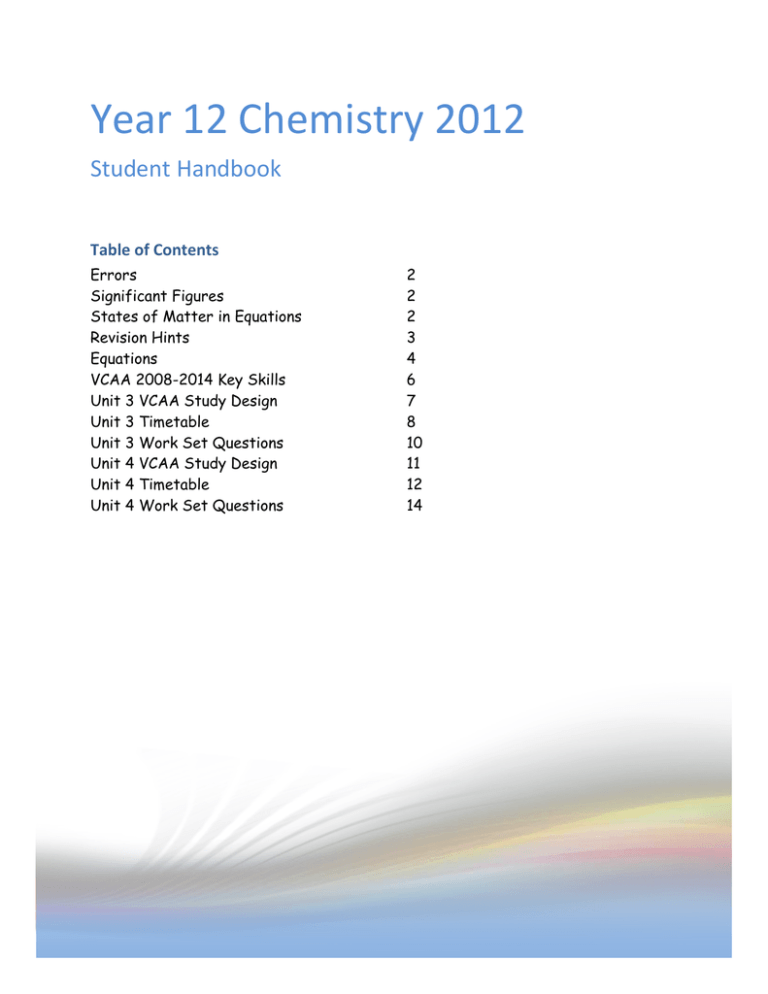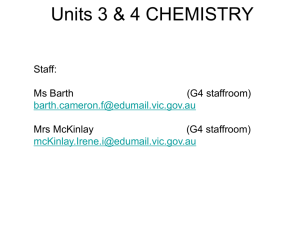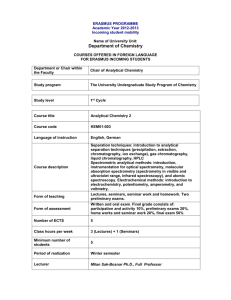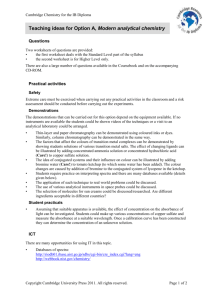Year 12 Chemistry 2012
advertisement

Year 12 Chemistry 2012 Student Handbook Table of Contents Errors Significant Figures States of Matter in Equations Revision Hints Equations VCAA 2008-2014 Key Skills Unit 3 VCAA Study Design Unit 3 Timetable Unit 3 Work Set Questions Unit 4 VCAA Study Design Unit 4 Timetable Unit 4 Work Set Questions 2 2 2 3 4 6 7 8 10 11 12 14 ERRORS When instruments are manufactured, there is a specified uncertainty within which the instrument is designed to deliver accurate results. You do not need to remember the various uncertainties of instruments exactly, however you are required to know the probable range (to within a power of 10) within which an instrument should operate. Typical uncertainties are: pipette ± 0.02 mL burette ± 0.02 mL top loading balances ± 0.005 g 10 mL measuring cylinders ± 0.1 mL 100 mL measuring cylinders ± 1 mL 250 mL standard flasks ± 0.2 mL Errors in experimental work can be classified in three categories: Gross Errors or Mistakes These are due to careless work or apparatus that is temporarily faulty. By being careful and repeating the experiment several times these errors are easily detected and eliminated. Systematic Errors These result from an error in the equipment. They can be eliminated by careful calibration of the instrument. Random Errors These errors arise from random variations. They cannot be eliminated, but are reduced by repeating the experiment several times and averaging the results. SIGNIFICANT FIGURES All of your numeric answers in the examination must be calculated to the correct number of significant figures. Generally you will lose one mark once only on your paper if your answers are incorrect to more one significant figure. Whilst one mark may not seem especially large, it is easy to express answers correctly. The following two rules will allow you to determine the correct number of significant figures. A significant figure is either an integer or a zero that follows an integer. For example: 0.0100 has three significant figures; 100 has three significant figures; 0.001 has one significant figure; 1001.0 has five significant figures; 0.0040 has two significant figures. When determining the number of significant figures for your answer, use the smallest number of significant figures present in the values you used for the calculation. For example: How many mole of hydrogen gas is present in a 5000 litre container at a pressure of 101.325 kPa and a temperature of 300 oC? Because the temperature is given to three significant figures, your answer can only be correct to three significant figures, despite the four for the volume and the six for the pressure. STATES OF MATTER IN EQUATIONS All reactants and products in equations should have their states correctly included. This means you must use the terms (aq), (g), (s) and (l) properly. If you have one incorrect or missing you will not be penalised. With more errors, you would lose one mark once only on your paper for incorrect labeling. 2 REVISION HINTS As part of your revision program, you should: Memorise all the key ideas including definitions, important equations, and details of instruments, industrial processes and cells. Go over the outcome statements in the Study Design. Go over questions you have done during the term from your textbook. You should be able to do this quite quickly. There is no need to do them all again; just select typical examples of each type. Try working out the main steps in your head to save time. Particularly select the questions with which you previously had difficulty or needed someone to show you. Complete past VCAA exam papers. The Sample Exams can be found via the CEA website, under VCE Chemistry, Links to VCAA Sample Exam 1 and Exam 2. All papers can be downloaded from the VCAA or CEA websites: www.cea.asn.au. The more past examinations you do, the better your marks will be. It is not necessary to do them as complete exams in 1.5 hours. As you revise topics, you can complete the appropriate questions, being careful to keep to the time suggested for each question. At other times you may decide that you need practice in doing multiple-choice questions. Mark your exams carefully from the answers provided. If you were incorrect, look at the appropriate section in your notes to assist your memory. Even if you are correct, it is important to read the correct answer fully. Whenever the examiner report states that this question was badly done, you can almost guarantee that the topic will be examined again in a very similar manner. Make sure you speak to your teacher about the problems you are constantly finding. When you complete 2 or 3 papers, read your notes completely to remind yourself regularly of the details of the course. During the weeks before the exams in June and November, this should occur at least twice a week until the exam. You should have one complete set of notes. Amalgamate all revision notes, class notes and summaries. YOUR REVISION TIMETABLE You should make up a revision timetable. Work backwards from your examinations. Naturally you will revise for a specific exam the night before. Be careful to allocate equal time during the prior weekend to all subjects in which you have an exam. Work backwards through the weeks before the exams. IN THE EXAM During the reading time read the whole paper slowly and carefully. Do not flip back and forward. During the reading time you will slow down your pulse rate and allow your thoughts to begin to work in an ordered way. Take some deep breaths and consciously regain your full composure. By reading with understanding your mind will start to work on the problems. During this time you may also find material in one section of the paper that will assist you with a different question! Decide whether you are doing the multiple-choice or structured questions first. When completing the multiple choice questions do all questions. Do not leave any blank, even if you have to guess. Before you hand in your paper, double check that you have answered all questions. Be careful to write the correct answer in the correct box. In case you misalign your answers, circle the correct letter in the exam booklet, allowing a quick check if needed at the end. 3 In the extended answer section, do the question of which you are most certain first. Check the time at the end of each question. Reread each question when you finished it and check you have answered all parts, balanced all equations, and included all states and units. If you complete your answer away from the expected section, clearly direct the marker to follow your working. Set out your answers clearly, stating the formulae you intend to use, as this often earns marks. e.g. n (NaOH) = c x V pH = - log10 [H3O+] EQUATIONS Equations must be memorised because no information can be taken in to the examination in your calculator memory. Your calculator must not be programmable 4 5 VCAA 2008-14 KEY SKILLS for UNITS 1 – 4 Investigate and inquire scientifically work independently and collaboratively as required to develop and apply safe and responsible work practices when completing all practical investigations including the appropriate disposal of wastes; conduct investigations that include collecting, processing, recording and analysing qualitative and quantitative data; draw conclusions consistent with the question under investigation and the information collected; evaluate procedures and reliability of data; construct questions (and hypotheses); plan and/or design, and conduct investigations; identify and address possible sources of uncertainty; apply ethics of scientific research when conducting and reporting on investigations. Apply chemical understandings make connections between concepts; process information; apply understandings to familiar and new contexts; use first and second-hand data and evidence to demonstrate how chemical concepts and theories have developed and been modified over time; analyse issues and implications relating to scientific and technological developments; analyse and evaluate the reliability of chemistry related information and opinions presented in the public domain. Communicate chemical information and understandings interpret, explain and communicate chemical information and ideas accurately and effectively; use communication methods suitable for different audiences and purposes; use scientific language and conventions correctly, including chemical equations and units of measurement. 6 UNIT 3 VCAA STUDY DESIGN Unit 3: Chemical pathways AREA OF STUDY 1: Chemical analysis Key knowledge This knowledge includes volumetric analysis: simple and back titrations, acid-base and redox titrations; gravimetric analysis; calculations including amount of solids, liquids and gases; concentration; volume, pressure and temperature of gases; use of oxidation numbers to write redox equations; principles and applications of chromatographic techniques and interpretation of qualitative and quantitative data from thin layer chromatography (TLC), high performance liquid chromatography (HPLC) and gas chromatography (GC); principles and applications of spectroscopic techniques and interpretation of qualitative and quantitative data from atomic absorption spectroscopy (AAS), infrared spectroscopy (IR), mass spectroscopy, nuclear magnetic resonance spectroscopy (NMR), and visible and ultraviolet spectroscopy UV-Visible); matching analytical technique/s to a particular task. AREA OF STUDY 2: Organic chemical pathways Key knowledge This knowledge includes structure and systematic nomenclature of alkanes, alkenes, amines, chloroalkanes, alkanols and carboxylic acids up to C10; common reactions of organic compounds: addition reactions of alkenes, substitution reactions of alkanes and primary chloroalkanes, oxidation of primary alkanols, esterification; principles of fractional distillation; organic reaction pathways including the production of esters from alkenes, condensation and polymerisation reactions that produce large biomolecules; primary, secondary and tertiary structure of proteins and the function of protein catalysts (enzymes); biochemical fuels including fermentation of sugars to produce ethanol; the structure and bonding of DNA and its applications in forensic analysis; use of proteins as markers for disease; function of organic molecules in the design and synthesis of medicines including the production of aspirin from salicylic acid. 7 VCE Chemistry Unit 3 Overview 2012 Semester 1 Week Term 1 1 (02/02/12) 2 (6/02/12) Topic Chapter 1: What’s Chemical Analysis? Practical/Activity/SAC Chapter 2: Analysis by Mass Chapter 2: Analysis by Mass Analysis of Sulphate in Fertiliser Chapter 3: Volumetric Analysis: Standard Titrations 3 (13/02/12) Chapter 4: Analysing Acids & Bases: Back Titrations Preparation of a Standard Solution Analysis of Brick Cleaner 4 (20/02/12) Chapter 5: Analysing Oxidants and Reductants Analysis of Nitrogen in Fertiliser by Back Titration 5 (27/03/12) Chapter 6: Chromatography 6 (05/03/12) Chapter 6 : Chromatography 7 (12/03/12) Chapter 7: Instrumental Analysis: Spectroscopy 8 (19/03/12) Chapter 7: Instrumental Analysis: Spectroscopy SAC 1: VSSEC Incursion Contemporary Chemical Analysis EEI (Monday March 19th & Thursday March 22nd) 9 (26/03/12) Chapter 9: Compounds of Carbon SAC 1: Contemporary Chemical Analysis EEI Final Write up Chromatography of Inks 8 Term 2 1 (16/04/12) 2 (23/04/12) (Anzac Day 25th) Chapter 7: Infrared/NMR Spectroscopy Chapter 8: Combining and choosing analytical techniques (Mass Spec) Chapter 10: Organic reactions: Pathways to New Products Constructing Models of Organic Demonstration :Synthesis of Oil of Wintergreen Chapter 11: Biochemical Fuels 3 (30/04/12) Chapter 12: Pathways to Biomolecules 4 (07/05/12) Chapter 12: Pathways to Biomolecules 5 (14/05/12) 6 (21/05/12) Chapter 13: DNA 7 (28/05/12) Examination Revision 8 (04/06/12) 9 (11/06/12) Examination Revision Chapter 14: From organic molecules to medicines SAC 2: Organic Reaction Pathways SAC 3: Biological & Medicinal Chemistry Mid Year Examinations Unit 3 Chemistry Exam 2012 Wednesday 13th June 9 VCE Chemistry Unit 3 2012 Work Set Questions Here are some work set questions from the text book which is required as preparation for the SACs and the examinations. It is strongly recommended that you complete all questions. The questions in bold are essential for a good understanding of the Chemistry course. The other questions will enhance your chances of doing well. In addition, you must attempt as many problems as possible from the Neap Smart study Guide and Cambridge Checkpoints Book as well as any past examination papers. Chemistry 3, AoS 1 Topic Chapter 1: What’s Chemical Analysis Chapter 2: Analysis by Mass Chapter 3: Volumetric Analysis Chapter 4: Analysing Acids and Bases Chapter 5: Analysing Oxidants and Reductants Chapter 6: Chromatography Chapter 7: Spectroscopy Chapter 8: Combining and Choosing Analytical Techniques Area of Study 1 Review (p 124) Work Set Questions 1, 5-6 5-8, 9, 10, 16, 17, 19, 20, 21, 24, 31, 34, 35, 36, 41, 44, 46, 48 1, 3, 4, 5, 6-8, 11, 14, 15, 16, 17, 18, 19, 20, 21, 23, 24, 25 5, 6, 7, 8, 9, 10, 13, 15, 16, 18, 20, 21, 22-24, 25, 26, 27, 28 1-5, 6, 7, 10, 11, 15, 18, 19, 22, 24, 25, 26, 28, 29, 31, 33, 34 2-4, 8, 10, 14, 19, 20, 21 5, 7, 9, 10, 12, 14, 15, 17, 18, 20, 23, 25, 29, 32, 33, 38, 40 1, 4, 5, 7, 8, 13, 16, 18, 20 All questions; Complete and revise all AoS 1 Chemistry 3, AoS 2 Topic Work Set Questions Chapter 9: Compounds of Carbon Chapter 10: Organic Reactions: Pathways to New Products Chapter 11: Biochemical Fuels Chapter 12: Pathways to Biomolecules 1-4, 8, 9, 11, 12, 13, 15, 16, 18, 20, 22, 23, 24 2, 3, 4, 6-9, 11, 13-17, 21, 22, 23-27, 29, 30, 33, 34 3, 11, 12, 13 1-3, 7, 8, 10, 12, 13, 14, 16, 17, 21, 29, 32, 33, 34, 41, 43, 45, 46 2, 6, 7, 17, 18 1, 5, 9, 13 Chapter 13: DNA Chapter 14: From Organic Molecules to Medicines Area of Study 2 Review (p 239) All questions; Complete and revise all AoS 2 10 UNIT 4 VCAA STUDY DESIGN Unit 4: Chemistry at work AREA OF STUDY 1: Industrial chemistry Key knowledge This knowledge includes collision theory and factors that affect the rate of a reaction including activation energy; energy profile diagrams and the use of ΔH notation; reversible reactions: homogeneous equilibria and the equilibrium law, Le Chatelier’s Principle and factors which affect the position of equilibrium; pH as a measure of strength of acids and bases; Kw, Ka for weak acids; principles of waste management used in the chemical industry; the industrial production of the selected chemical: – factors affecting the production including rate and equilibrium position, catalysts, temperature, pressure – waste management including generation, treatment and reduction – health and safety – uses of the selected chemical. AREA OF STUDY 2: Supplying and using energy Key knowledge This knowledge includes comparison of energy sources: types, uses and sustainability of sources including brown coal, natural gas, nuclear fission and biochemical fuels; application of calorimetry to measure energy changes in chemical reactions in solution Calorimetry and bomb calorimetry; use of the electrochemical series in predicting the products of redox reactions and writing half equations; limitations of predictions made using the electrochemical series; the construction and operation of simple galvanic primary and secondary cells; the construction and operation of fuel cells: advantages and disadvantages of fuel cells compared to conventional energy sources; the construction and operation of simple electrolytic cells: comparison of electrolytic cells; application of Faraday’s laws in electrochemistry. 11 VCE Chemistry Unit 4 Overview 2012 Semester 2 Week Topic Chapter 15: Fast and Slow chemistry Practical/Activity/SAC Practicals for SAC 1: Rates of Chemical Reactions 11 (25/06/12) Chapter 16: Controlling the yield of reactions Practicals for SAC 1: Le Chatelier’s Principle Effect of Concentration on Equilibrium Term 3 1 (16/07/12) Chapter 16: Controlling the yield of reactions Practicals for SAC 1: Le Chatelier’s Principle Effect of Temperature on Equilibrium 2 (23/07/12) Chapter 17: Equilibria involving Acid and bases SAC 1: Equilibrium 3 (06/08/12) Chapter 18: Chemical Industry: Risks and Rewards Properties of Sulphuric Acid Term 2 10 (18/06/12) Chapter 21: Production of Sulphuric Acid 4 (13/08/12) Chapter 23 : Fossil Fuels 5 (20/08/12) Chapter 24: Alternative Energy Sources Chapter 25: Energy from Chemical Reactions 6 (27/08/12) Chapter 26: Electricity from chemical reactions 7 (03/09/12) Chapter 26: Electricity from chemical reactions Heat of Combustion of Candle Wax Calibration of a Calorimeter SAC 2: Enthalpy Changes in Chemical Reactions Chapter 27: Cells and batteries 12 8 (10/09/12) 9 (17/09/12) Term 4 Chapter 28: Electrolysis: Driving Chemical Reactions by Electricity Half Cells and the Electrochemical Series Electroplating or Faraday’s First Law of Electrolysis Chapter 28: Electrolysis: Driving Chemical Reactions by Electricity SAC 3: Applications of Electrolytic and Electrochemical Cells Chapter 27: Cells and Batteries Examination Revision 1 (08/10/12) 2 (15/10/12) Examination Revision 3 (22/10/12) Examination Revision 13 VCE Chemistry Unit 4 2012 Work Set Questions Here are some work set questions from the text book which is required as preparation for the SACs and the examinations. It is strongly recommended that you complete all questions. The questions in bold are essential for a good understanding of the Chemistry course. The other questions will enhance your chances of doing well. In addition, you must attempt as many problems as possible from the Neap Smart study Guide and Cambridge Checkpoints Book as well as any past examination papers. Chemistry 3, AoS 1 Topic Work Set Questions Chapter 15: Fast and Slow Chemistry 1, 2, 4, 6, 8, 9, 10, 12, 15, 18, 20 Chapter 16: Controlling the Yield of Reactions 3, 5, 6,7, 8, 9, 10, 11, 12, 13-15, 17-21, 23, 2532, 36, 37 Chapter 17: Equilibria Involving Acids and Bases Chapter 18: The Chemical Industry 1, 2, 3, 5, 6, 7, 9, 10, 11, 13, 14, 15, 16-22. Chapter 21: Production of Sulphuric Acid Area of Study 1 Review (p 360) 1, 2, 5, 7, 8, 9, 13, 15, 18 All questions; Complete and revise all AoS 1 9, 13, 15, 28, 32 Chemistry 4, AoS 2 Topic Work Set Questions Chapter 23: Fossil Fuels 4, 5, 8, 9, 11 Chapter 24: Alternate Energy Sources Chapter 25: Energy from Chemical Reactions 8, 12, 14, 15, 18 2, 4, 5, 6, 7, 10, 11, 13, 21, 22, 24, 26, 28, 33, 34, 35, 36 Chapter 26: Electricity from Chemical Reactions Chapter 27: Cells and Batteries 1, 4, 5, 6, 7, 8, 9, 10, 11, 13, 14 Chapter 28: Electrolysis: Driving Chemical Reactions by Electricity 3-7, 8, 9, 11, 12, 14, 17, 18, 19, 20, 23, 25, 26, 29, 30, 31, 33 Area of Study 2 Review (p 463) All questions; Complete and revise all AoS 2 5, 12, 13, 14, 19, 21, 23 14 15





